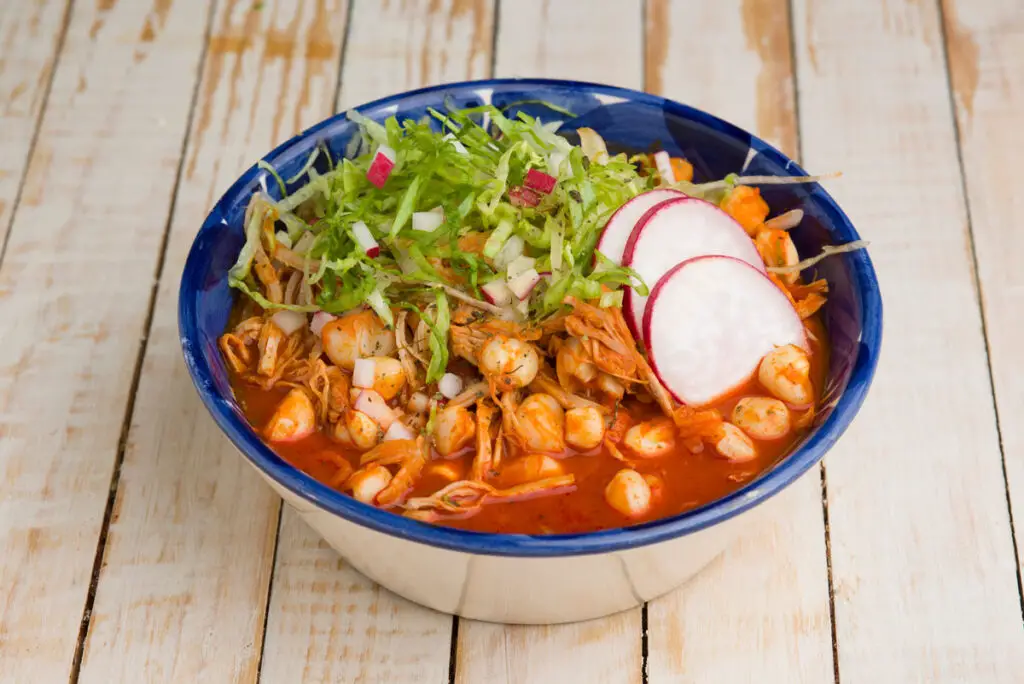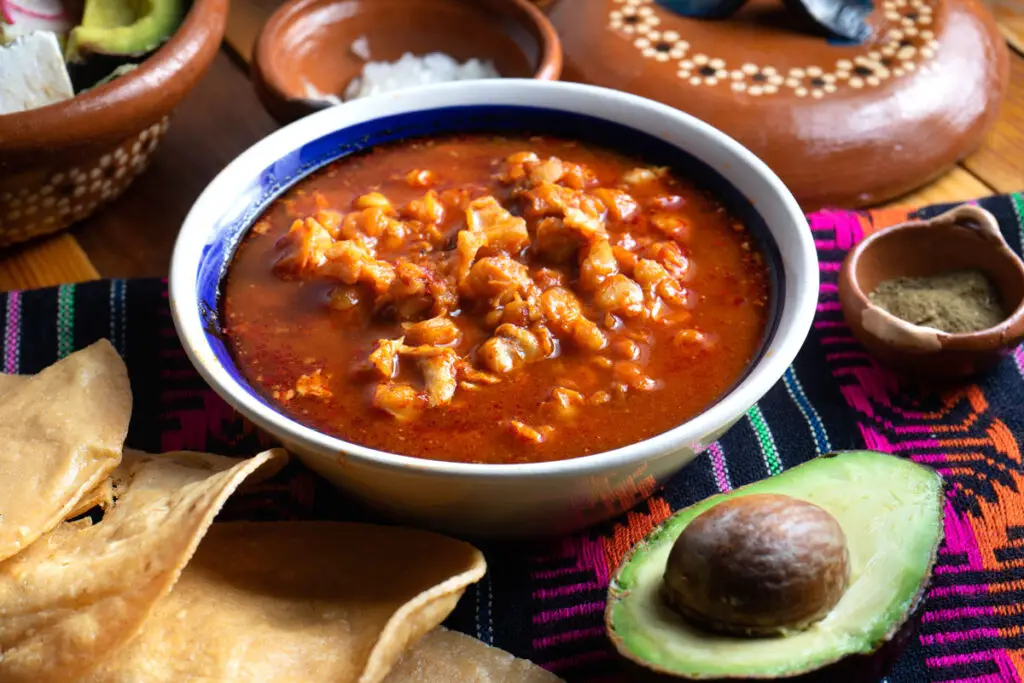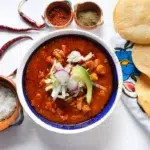Pozole, a dish deeply rooted in Mexican culture, has a story that’s as rich and layered as its flavor. Often enjoyed during festive gatherings or as a hearty remedy for a long night, this beloved maize stew carries centuries of tradition. But beneath its heartwarming appearance lies a history steeped in ancient rituals, colonial influences, and modern-day adaptations. From its origins in Aztec ceremonies to its transformation under Spanish rule, the real story of pozole is a fascinating journey through time, culture, and cuisine.
This article unpacks the evolution of pozole, exploring its ritualistic roots, its grisly ties to human sacrifice, and its rebirth as a treasured Mexican dish. So grab a bowl (preferably filled with pozole) and join us as we uncover the real story of pozole.
Origins of Pozole in Ancient Mesoamerican Culture
The Meaning of “Pozolli” in Nahuatl
The Aztec empire first prepared pozole, naming it “pozolli” from the Nahuatl language. The word loosely translates to “a stew made from maize,” with maize (or corn, as we know it) holding deep cultural and spiritual significance in Mesoamerican societies. The Aztecs revered maize as a divine gift, believing it formed the very substance of human creation. This sacred connection led them to make maize-based dishes like pozole a central part of their rituals and ceremonies.
Pozole wasn’t just food; it was symbolic. The hearty maize kernels, cooked to a tender perfection, represented life, fertility, and sustenance. By consuming pozole, the Aztecs connected themselves to the divine, affirming their place in the cosmic cycle of life and renewal.
Ritualistic Beginnings
In ancient Mesoamerica, pozole was no ordinary meal—it was a dish reserved for special occasions and ceremonies. The Aztecs believed food was a way to honor their gods, celebrate the changing seasons, and mark significant events. During rituals dedicated to deities like Tláloc, the rain god, or Xipe Tótec, the god of fertility and renewal, pozole played a central role.
These ceremonies often coincided with the agricultural calendar. For instance, during Tlacaxipehualiztli, a spring festival marking the planting season, maize offerings were paired with elaborate feasts. Pozole, as the centerpiece of these meals, symbolized gratitude and the hope for bountiful harvests.
Interestingly, the original recipe for pozole was vastly different from what we know today. The base ingredients—maize and water—remained constant, but the proteins varied significantly. While modern pozole often features pork or chicken, the Aztecs used wild animals like tepezcuintle, a large rodent. This variation reflected the dish’s role in connecting people to the natural world and their surroundings.
As we’ll see in the next section, some rituals tied to pozole took on a darker, more controversial turn. Stay tuned as we dive deeper into the history of the real story of pozole.
Human Sacrifice and Its Connection to Pozole

Tlacatlaolli: A Maize Stew with a Gruesome Twist
The real story of pozole? It’s not all about comfort food and celebrations. In pre-Hispanic Mesoamerica, pozole’s role went far beyond the dinner table—it was a vital part of ceremonial rituals, some of which involved human sacrifice. Known as tlacatlaolli, an early version of pozole was documented in the Florentine Codex, a 16th-century manuscript by Spanish missionary Fray Bernardino de Sahagún.
During these rituals, the Aztecs sacrificed captives to honor the gods and cooked their remains with maize to create a stew. They didn’t view this act as gruesome; instead, they saw it as a way to achieve communion with the divine. Participants shared the meal, which they believed strengthened their connection to the gods and nature. In this context, they used pozole as both a sacred offering and a tool for spiritual unity.
The dish also reflected the dualities so prominent in Aztec philosophy: life and death, nourishment and destruction, earth and the heavens. The white maize kernels, representing purity, were paired with human flesh to symbolize the intricate balance between mortality and the divine.
Transition to Modern Proteins
After the Spanish conquest in the 16th century, this grisly aspect of pozole was abolished. The Spanish colonizers, appalled by the practice of cannibalism, outlawed it. However, instead of erasing pozole entirely, they adapted it. Pork, introduced by the Spanish, replaced human flesh in the recipe.
Why pork? Remarkably, it was considered similar in taste to human flesh, making it a suitable substitute for preserving the dish’s traditional essence. This change marked the beginning of pozole’s transformation from a ritualistic food into a communal one.
Though these darker aspects of pozole’s history are often omitted today, they remain a key part of the real story of pozole, showing how food can embody both tradition and transformation.
Evolution of Pozole Through Colonial Times
Spanish Influence on Ingredients
The Spanish conquest didn’t just change the political and social landscape of Mexico; it also reshaped its culinary traditions. Pozole, like many indigenous dishes, underwent significant changes as new ingredients and cooking methods were introduced. Pork, as we’ve seen, became a staple protein in pozole, but other influences shaped the dish as well.
Spices such as garlic and onions, brought over by the Spanish, were integrated into pozole recipes. These additions not only enhanced the flavor but also gave the dish a new identity. What was once a ceremonial meal for the Aztecs began evolving into a comfort food enjoyed by families across generations.
Banning of Ritual Cannibalism
The Spanish colonizers didn’t just influence the ingredients—they also banned the rituals surrounding tlacatlaolli. Determined to convert the indigenous people to Christianity, they saw practices like human sacrifice as barbaric and incompatible with their beliefs. By outlawing these rituals, they stripped pozole of its sacred role and placed it firmly within the realm of everyday cuisine.
However, the dish’s cultural significance wasn’t entirely lost. Even without its ritualistic ties, pozole continued to represent community and celebration. Families gathered to share the hearty stew, preserving the essence of unity that had always been at the heart of the dish.
Today, while its ancient roots may be less known, the real story of pozole lives on in every pot of this flavorful stew. Its journey from sacred offering to beloved comfort food reflects the resilience of Mexican culture and its ability to adapt while honoring tradition.
Modern Variations of Pozole
Pozole Rojo, Verde, and Blanco: Regional Specialties
One of the best things about pozole today is its variety. From the fiery pozole rojo to the vibrant pozole verde and the subtle pozole blanco, this dish has evolved into a celebration of Mexico’s regional diversity. Each variation brings unique flavors, ingredients, and traditions to the table.
- Pozole Rojo: This version gets its rich red hue from dried chilies like guajillo or ancho. It’s popular in central Mexico, particularly in states like Guerrero and Jalisco. The bold, smoky flavors make it a favorite during celebrations.
- Pozole Verde: Originating in Guerrero, this green version uses fresh green chilies, tomatillos, and herbs like epazote or cilantro. It’s lighter yet packed with flavor, often paired with chicken.
- Pozole Blanco: The simplest of the three, this version skips the chilies, letting the natural flavors of the hominy and broth shine. It’s common in the northern regions and is a blank canvas for creative garnishes.
Regardless of the version, garnishes like shredded cabbage, radishes, lime, and oregano add the finishing touches, making pozole a versatile and customizable dish.
Globalization of Pozole
Thanks to globalization and the Mexican diaspora, pozole has crossed borders and gained popularity worldwide. Mexican-American communities in the U.S. have embraced pozole, serving it during family gatherings, Christmas, and other celebrations. While it’s traditionally homemade, pozole can now be found in restaurants, bringing a taste of Mexico to global palates.
For those eager to try their hand at making pozole, check out this guide to pozole history and cooking tips for authentic insights and recipes.
Pozole’s Cultural Significance Today
Pozole as a Dish for Celebration
Today, pozole is more than just a meal—it’s a symbol of togetherness. Whether it’s served during weddings, Dia de los Muertos, or a casual Sunday gathering, pozole brings people together. Its communal nature harks back to its ceremonial roots, though the context has shifted from religious offerings to family traditions.
Many families pass down their pozole recipes through generations, adding their unique touches. Some use pork, while others prefer chicken. Some stick to traditional seasonings, while others experiment with modern twists. No matter the variation, pozole remains a unifying dish.
Revival of Historical Context
In recent years, there’s been a renewed interest in the history behind pozole. Documentaries, cookbooks, and culinary historians have revisited the real story of pozole, shedding light on its pre-Hispanic origins and its journey through colonial times. This revival not only enriches our appreciation of the dish but also honors the resilience of Mexican culture.
For those intrigued by the fusion of history and flavor, pozole offers a window into Mexico’s past and present. As you savor each spoonful, you’re partaking in a tradition that’s endured for centuries, blending ancient rituals with modern flavors.
Frequently Asked Questions
What Is the Origin of the Word “Pozole”?
The word pozole comes from the Nahuatl language, where “pozolli” refers to a stew made with maize. Maize, considered sacred by the Aztecs, formed the foundation of this dish. Over time, the name stuck, preserving its connection to its ancient roots.
Was Human Sacrifice Really Part of Pozole’s History?
Yes, though it sounds shocking today, the real story of pozole involves a connection to human sacrifice. During Aztec rituals, human flesh was included in the stew as an offering to the gods. This practice was banned after the Spanish conquest, and pork became the primary protein.
What Are the Main Types of Pozole?
Pozole comes in three primary varieties: rojo, verde, and blanco. Each variation features unique ingredients, with chilies adding color and flavor in the red and green versions. Meanwhile, pozole blanco offers a simpler, broth-focused taste.
How Has Pozole Changed Since Pre-Colonial Times?
Pozole has transformed significantly. Originally a ritualistic dish, it became a communal meal after the Spanish conquest. Today, it’s enjoyed in celebrations and family gatherings, showcasing its versatility and enduring appeal.

Related Recipes and Final Thoughts
Related Recipes for Food Lovers
For those intrigued by culinary traditions like pozole, there’s much more to explore! If you enjoy hearty dishes steeped in history, consider trying other recipes like barbacoa or frijoles puercos. Check out this article on barbacoa’s history and tips for an authentic perspective. These recipes, like pozole and even modern cookie cakes, bring families together and tell stories through flavors.
Final Thoughts
Pozole isn’t just a meal—it’s a time capsule, blending ancient traditions with modern tastes. From its ritualistic origins to its current status as a family favorite, the real story of pozole reflects the resilience and creativity of Mexican cuisine. Whether it’s served during holidays, weddings, or a casual Sunday, pozole continues to unite families and communities.
As you explore its history and savor its flavors, remember that every bowl of pozole carries a story—a story that links the past with the present, celebrating both heritage and innovation.
Health Benefits and Nutritional Insights of Pozole
Is Pozole a Nutritious Dish?
Yes, pozole is both flavorful and nutritious, thanks to its wholesome ingredients. At its core, the real story of pozole lies in its use of hominy, a form of maize that’s high in dietary fiber, complex carbohydrates, and essential vitamins like B6 and folate. Hominy is also gluten-free, making pozole suitable for those with dietary restrictions.
The dish is often paired with fresh toppings like shredded cabbage, radishes, and lime, which add vitamins C and K while boosting its overall nutritional value. Proteins such as pork, chicken, or even turkey provide a good dose of essential amino acids, making pozole a hearty, well-rounded meal.
Can Pozole Be Made Healthier?
Absolutely! While traditional recipes can be rich, especially those using pork, there are lighter variations. For example, substituting chicken for pork reduces fat content without sacrificing flavor. Opting for low-sodium broth and avoiding excessive toppings like sour cream can also make it more heart-healthy.
Another tip is to increase the vegetable ratio. Adding zucchini, spinach, or bell peppers not only enhances the flavor but also boosts the dish’s vitamin and mineral content. Pozole remains adaptable to different preferences, proving its place as a timeless and nutritious option.
How Pozole Inspires Modern Cuisine
Modern Twists on a Classic Dish
While the roots of pozole are firmly planted in history, its adaptability has allowed it to inspire modern dishes. Chefs worldwide have reimagined this classic stew, incorporating unique ingredients or presenting it in new ways. For example, pozole-inspired ramen or pozole tacos have become popular fusion dishes, merging Mexican and international flavors.
Additionally, vegan and vegetarian versions of pozole have gained traction. Instead of meat, chefs use mushrooms, jackfruit, or beans to recreate the dish’s rich texture while keeping it plant-based. These innovations honor the real story of pozole while catering to modern tastes.
Pozole as a Cultural Ambassador
Beyond its traditional recipe, pozole serves as a symbol of Mexican heritage, showcasing the country’s culinary depth and diversity. As it appears on menus and in kitchens worldwide, pozole invites people to learn about its origins and appreciate the culture it represents. Its journey from sacred rituals to global recognition speaks to its enduring significance.
Whether enjoyed in its classic form or a modern twist, pozole continues to evolve while staying true to its roots. It’s a dish that tells a story—a story of tradition, adaptation, and the universal love of good food.
Print
The real story of pozole
- Prep Time: 20 minutes (Gathering ingredients, preparing chilies, and chopping garnishes)
- Cook Time: 2 hours 30 minutes (Simmering the broth, cooking the meat, and blending the chili sauce)
- Total Time: 2 hours 50 minutes
Ingredients
- Pork shoulder or chicken (around 2 lbs) – the primary protein.
- Hominy (2 cans or about 4 cups cooked) – the star ingredient.
- Onion (1 medium, peeled and halved) – for flavoring the broth.
- Garlic cloves (4–5, peeled) – adds depth to the broth.
- Bay leaves (2–3) – for a fragrant broth.
- Salt (to taste) – essential seasoning.
For Pozole Rojo (Red Pozole):
- Dried chilies (3–4 guajillo and 2–3 ancho or pasilla) – soaked and blended for the chili sauce.
- Cumin (1 tsp) – enhances the chili flavor.
- Oregano (1 tsp) – adds a herbaceous touch.
For Garnishes:
- Shredded cabbage or lettuce – adds crunch.
- Sliced radishes – for a peppery bite.
- Lime wedges – for a fresh, tangy flavor.
- Dried oregano – to sprinkle on top.
- Crushed chili flakes (optional) – for heat.
- Avocado slices (optional) – for creaminess.
- Tostadas or tortilla chips – served on the side.
Optional Variations:
- Use chicken or turkey instead of pork for a lighter version.
- Substitute pork with mushrooms or jackfruit for a vegetarian or vegan version.
Instructions
Step 1: Prepare the Broth
- In a large pot, add the pork shoulder (or chicken), onion, garlic cloves, and bay leaves.
- Fill the pot with enough water to cover the ingredients and bring it to a boil over medium-high heat.
- Skim off any foam or impurities that rise to the surface.
- Reduce the heat to low, cover, and simmer for about 2 hours (or until the meat is tender and easily shredded).
- Once cooked, remove the meat from the pot and set it aside. Strain the broth and return it to the pot.
Step 2: Make the Chili Sauce (For Pozole Rojo)
- While the broth simmers, remove the stems and seeds from the dried chilies (guajillo and ancho or pasilla).
- Soak the chilies in hot water for 15–20 minutes, until softened.
- Blend the soaked chilies with 1 cup of the soaking water, garlic, oregano, and cumin until smooth.
- Strain the chili sauce through a fine sieve to remove any solids.
Step 3: Assemble the Pozole
- Add the hominy to the pot of strained broth and bring it to a simmer.
- Stir in the chili sauce (if making pozole rojo) and mix until fully incorporated.
- Shred the cooked meat and add it back to the pot. Simmer for 20–30 minutes to let the flavors meld.
- Taste and adjust seasoning with salt and additional spices as needed.
Step 4: Serve and Garnish
- Ladle the pozole into bowls.
- Garnish with shredded cabbage or lettuce, sliced radishes, lime wedges, dried oregano, and avocado slices as desired.
- Serve with tostadas or tortilla chips on the side.
Optional Tips:
- For pozole verde, blend fresh green chilies, tomatillos, and herbs like cilantro, then stir into the broth instead of the red chili sauce.
- For a vegetarian version, skip the meat and use vegetable broth with mushrooms or jackfruit.
Enjoy your flavorful, comforting bowl of pozole!
Nutrition
- Serving Size: 1 cup (approx. 250g)
- Calories: 280 kcal
- Sugar: 2g
- Sodium: 650mg
- Fat: 9g
- Saturated Fat: 3g
- Unsaturated Fat: 6g
- Trans Fat: 0g
- Carbohydrates: 25g
- Fiber: 4g
- Protein: 20g
- Cholesterol: 50mg

